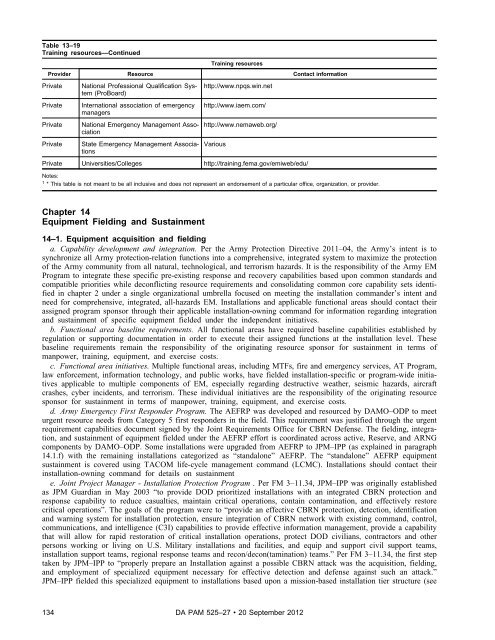Army Emergency Management Program - Federation of American ...
Army Emergency Management Program - Federation of American ...
Army Emergency Management Program - Federation of American ...
You also want an ePaper? Increase the reach of your titles
YUMPU automatically turns print PDFs into web optimized ePapers that Google loves.
Table 13–19<br />
Training resources—Continued<br />
Training resources<br />
Provider Resource Contact information<br />
Private National Pr<strong>of</strong>essional Qualification System<br />
(ProBoard)<br />
Private International association <strong>of</strong> emergency<br />
managers<br />
Private National <strong>Emergency</strong> <strong>Management</strong> Association<br />
Private State <strong>Emergency</strong> <strong>Management</strong> Associations<br />
http://www.npqs.win.net<br />
http://www.iaem.com/<br />
http://www.nemaweb.org/<br />
Various<br />
Private Universities/Colleges http://training.fema.gov/emiweb/edu/<br />
Notes:<br />
1 * This table is not meant to be all inclusive and does not represent an endorsement <strong>of</strong> a particular <strong>of</strong>fice, organization, or provider.<br />
Chapter 14<br />
Equipment Fielding and Sustainment<br />
14–1. Equipment acquisition and fielding<br />
a. Capability development and integration. Per the <strong>Army</strong> Protection Directive 2011–04, the <strong>Army</strong>’s intent is to<br />
synchronize all <strong>Army</strong> protection-relation functions into a comprehensive, integrated system to maximize the protection<br />
<strong>of</strong> the <strong>Army</strong> community from all natural, technological, and terrorism hazards. It is the responsibility <strong>of</strong> the <strong>Army</strong> EM<br />
<strong>Program</strong> to integrate these specific pre-existing response and recovery capabilities based upon common standards and<br />
compatible priorities while deconflicting resource requirements and consolidating common core capability sets identified<br />
in chapter 2 under a single organizational umbrella focused on meeting the installation commander’s intent and<br />
need for comprehensive, integrated, all-hazards EM. Installations and applicable functional areas should contact their<br />
assigned program sponsor through their applicable installation-owning command for information regarding integration<br />
and sustainment <strong>of</strong> specific equipment fielded under the independent initiatives.<br />
b. Functional area baseline requirements. All functional areas have required baseline capabilities established by<br />
regulation or supporting documentation in order to execute their assigned functions at the installation level. These<br />
baseline requirements remain the responsibility <strong>of</strong> the originating resource sponsor for sustainment in terms <strong>of</strong><br />
manpower, training, equipment, and exercise costs.<br />
c. Functional area initiatives. Multiple functional areas, including MTFs, fire and emergency services, AT <strong>Program</strong>,<br />
law enforcement, information technology, and public works, have fielded installation-specific or program-wide initiatives<br />
applicable to multiple components <strong>of</strong> EM, especially regarding destructive weather, seismic hazards, aircraft<br />
crashes, cyber incidents, and terrorism. These individual initiatives are the responsibility <strong>of</strong> the originating resource<br />
sponsor for sustainment in terms <strong>of</strong> manpower, training, equipment, and exercise costs.<br />
d. <strong>Army</strong> <strong>Emergency</strong> First Responder <strong>Program</strong>. The AEFRP was developed and resourced by DAMO–ODP to meet<br />
urgent resource needs from Category 5 first responders in the field. This requirement was justified through the urgent<br />
requirement capabilities document signed by the Joint Requirements Office for CBRN Defense. The fielding, integration,<br />
and sustainment <strong>of</strong> equipment fielded under the AEFRP effort is coordinated across active, Reserve, and ARNG<br />
components by DAMO–ODP. Some installations were upgraded from AEFRP to JPM–IPP (as explained in paragraph<br />
14.1.f) with the remaining installations categorized as “standalone” AEFRP. The “standalone” AEFRP equipment<br />
sustainment is covered using TACOM life-cycle management command (LCMC). Installations should contact their<br />
installation-owning command for details on sustainment<br />
e. Joint Project Manager - Installation Protection <strong>Program</strong> . Per FM 3–11.34, JPM–IPP was originally established<br />
as JPM Guardian in May 2003 “to provide DOD prioritized installations with an integrated CBRN protection and<br />
response capability to reduce casualties, maintain critical operations, contain contamination, and effectively restore<br />
critical operations”. The goals <strong>of</strong> the program were to “provide an effective CBRN protection, detection, identification<br />
and warning system for installation protection, ensure integration <strong>of</strong> CBRN network with existing command, control,<br />
communications, and intelligence (C3I) capabilities to provide effective information management, provide a capability<br />
that will allow for rapid restoration <strong>of</strong> critical installation operations, protect DOD civilians, contractors and other<br />
persons working or living on U.S. Military installations and facilities, and equip and support civil support teams,<br />
installation support teams, regional response teams and recon/decon(tamination) teams.” Per FM 3–11.34, the first step<br />
taken by JPM–IPP to “properly prepare an Installation against a possible CBRN attack was the acquisition, fielding,<br />
and employment <strong>of</strong> specialized equipment necessary for effective detection and defense against such an attack.”<br />
JPM–IPP fielded this specialized equipment to installations based upon a mission-based installation tier structure (see<br />
134 DA PAM 525–27 20 September 2012
















